
|
Sale 28
Pre-Long Beach Coin Auction
| Lot |
Photo |
Description |
Realized |
Lot 788 |
 |
Maryland Shilling. PCGS graded EF-40. Dark gray surfaces with hints of a lighter antique gray underneath. Struck slightly off-center by several degrees at 7:00 on the obverse, shifting the legend to the right at 3:00. The faintest hairlines are seen on the obverse fields. A strong portrait with the hair typically weak at top due to buckling. The reverse shows the often seen raised clash mark below the II on the reverse. Hints of lavender rest on top of the shield. The legends, devices and fields are surprisingly free from any marks or planchet flaws. A very appealing and solid specimen. PCGS has graded 5 in EF-40 with 16 finer.
Estimated Value $13,000 - 15,000.
View details and enlarged photos
| Realized
$16,100 |
Lot 789 |
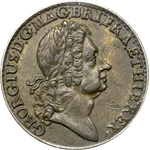 |
1723 Rosa Americana Penny. PCGS graded AU-55. Dark brown surfaces with brass highlights. Small planchet depression in field below A of FRA. Another below R of REX. The entire coin, obverse and reverse, is boldly defined and pleasing. William Wood, an English entrepreneur, had visions of grandeur when he persuaded King George I to grant him a patent allowing him to issue approximately 100 tons of base-metal coins to the American plantations. After malice intervention by King George's mistress, Wood's plans for the issue of this coinage became quite sticky and eventually led to production using lower weight standards and an impure and unsatisfactory alloy. PCGS has graded 5 in AU-55, 9 in AU58 and 2 in MS-62 as finest (PCGS # 125) .
Estimated Value $1,200 - 1,500.
View details and enlarged photos
Check results on similar lots
| Realized
$1,725 |
Lot 790 |
 |
1723 Wood's Hibernia Halfpenny. PCGS graded MS-64 Brown. Smooth glossy brown surfaces with hints of mint red. A few very small planchet problems on the cheek. Lustrous and a high grade example of this issue. Die crack on the reverse from B to N of HIBERNIA. A small patch of die rust remnants around the reverse device. PCGS population of 20 in MS-64 BN with 5 finer in MS-65BN. (PCGS # 180) .
Estimated Value $800 - 900.
View details and enlarged photos
Check results on similar lots
| Realized
$1,495 |
Lot 791 |
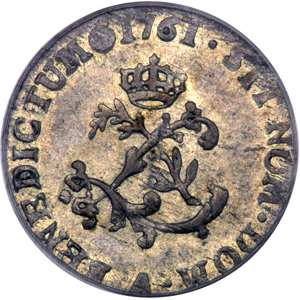 |
1760 French Colonies Sou Marque. PCGS graded AU-58. Lightly toned with traces of mint luster still evident. In an old green holder.
Estimated Value $400 - 450.
View details and enlarged photos
| Realized
$552 |
Lot 792 |
 |
1776 Continental Currency. "CURRENCY". Pewter. . Newman 2-C, Rarity-3. PCGS graded MS-63 PQ. 239.4 gns. Twin olive leaf edge device. An astounding, prooflike example with light gray surfaces and touches of smoky toning. Fully mirrored fields emit yellow iridescence when tilted. The numerals of the sundial, the lettering and each ray surrounding the concentric circles containing "We Are One" are razor sharp, as if produced last year. A nice Extremely Fine example will generally leave someone new to the coin in awe, this example will leave someone who has handled dozens of these astounded, in shock, at its near-gem state and unbelievable detail. The mind can literally run for endless hours contemplating the characters of our past who had a hand in carrying this piece of treasure over the past 230 years. In today's numismatic marketplace, this issue is gobbled up as soon as one appears, ending up in the hands of collectors and dealers who see no need to sell any time soon. The present outstanding specimen presents the opportunity for someone to acquire what could quite possibly be the finest known example of this type! When catalogued as part of the Ford Sale (Lot #5, Part 1), this specimen was graded "Gem Brilliant Uncirculated. Prooflike" and we could not agree more. When considering the conditions under which this coin was produced and the current aged beauty, how could this piece be anything other than "gem". A magnificent rarity that should excite legions of collectors and dealers (PCGS # 794) .
Estimated Value $50,000 - 70,000.
Ex-John J. Ford; F.C.C. Boyd Collection; Hillyer Ryder; George H. Earle Collection.
View details and enlarged photos
Check results on similar lots
| Realized
$92,000 |
Lot 793 |
 |
1783 Nova Constellatio. Blunt rays. PCGS graded AU-50. Light chocolate brown surfaces with bold lettering and devices throughout. A small lintmark to the right of S of US. Planchet quality is free from porosity or granularity. PCGS has graded 9 in AU-50 with 14 finer (PCGS # 807) .
Estimated Value $1,000 - 1,200.
View details and enlarged photos
Check results on similar lots
| Realized
$2,070 |
Lot 794 |
|
1788 Massachusetts Cent. Period After Massachusetts. PCGS graded VF-30. Streaks of dark and light chocolate brown on the obverse. The reverse is brown with stronger blond highlights. Planchet is quality is good and displays no real planchet flaws. Period is soft but visible after Massachusetts.
Estimated Value $350 - 400.
View details
| Realized
$345 |
Lot 795 |
|
1788 Massachusetts Cent. PCGS graded VF-30. Sharpness finer than VF. Housed in an old PCGS green label holder. The word CENT bold in shield. Slightly porous planchet. Even dark brown color with tan high points (PCGS # 311) .
Estimated Value $350 - 400.
View details
Check results on similar lots
| Unsold |
Lot 796 |
 |
1787 Connecticut. Draped bust facing left. PCGS graded VF-30. Reddish-brown surfaces that are slightly porous. Struck a little off-center and some letters in the legend are soft (PCGS # 370) .
Estimated Value $350 - 400.
View details and enlarged photos
Check results on similar lots
| Realized
$380 |
Lot 797 |
 |
1785 Vermont. "Vermonts". NGC graded EF-40 Brown. Mottled appearance on the lower obverse with a mixture of light and dark brown. Struck a little off-center on both obverse and reverse and consequently lettering missing on both obverse and reverse. The planchet quality is good. The landscape design is sharp. A pleasant example of this popular and scarce issue with solid eye appeal.
Estimated Value $3,000 - 3,500.
View details and enlarged photos
| Realized
$3,335 |
Lot 798 |
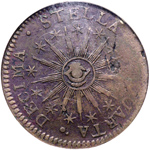 |
1786 Vermont. "Vermontensium". NGC graded VF-35 Brown. The most common variety of the landscape Vermont coppers. Landscape detail is sharp. Plow detail is lacking most of its' definition. Light porosity on both sides of the planchet and a planchet flaw at the rays across from 3:00. Well-centered for the most part and the lettering is mostly present except for the 3:00 region on the reverse and 6:00 on the obverse.
Estimated Value $1,000 - 1,250.
View details and enlarged photos
| Realized
$1,553 |
Lot 799 |
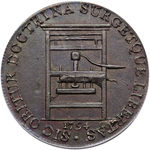 |
1794 Franklin Press token. PCGS graded MS-63 Brown. Well struck and enhanced by radial luster. Original mint red seen under the uniform glossy chocolate surfaces. There are gun-metal blue and olive hues on the obverse as well. The reverse has stronger remnants of original mint red. The ususal die break at the press. Always important to the colonial and type collector due to the association with Franklin. PCGS has graded 9 in this grade and only 7 higher, the finest a MS-65BN. (PCGS # 630) .
Estimated Value $900 - 1,100.
View details and enlarged photos
Check results on similar lots
| Realized
$1,438 |
Lot 800 |
 |
1794 Franklin Press token. PCGS graded MS-62 Brown. Glossy brown and hints of mint red (PCGS # 630) .
Estimated Value $800 - 900.
View details and enlarged photos
Check results on similar lots
| Realized
$1,093 |
Lot 801 |
 |
1794 Franklin Press token. NGC graded MS-62 Brown. Nice radial luster is seen rotating around the press. A well-centered planchet and correspondingly sharp and complete lettering. There is a small planchet clip at 10:00 on the obverse (and the corresponding part of the reverse). Pleasant chocolate brown surfaces with hints of reddish-brown.
Estimated Value $550 - 650.
View details and enlarged photos
| Realized
$719 |
Lot 802 |
|
1795 Talbot, Allum & Lee Token Cent. PCGS graded AU-55. Well struck on a centered planchet that is solid and nice. Dark chocolate brown with bronze highlights. An old dull nick to the right of Liberty's arm. Wave detail is very sharp and impressive (PCGS # 640) .
Estimated Value $350 - 400.
View details
Check results on similar lots
| Realized
$380 |
Lot 803 |
|
1783 Washington token. "UNITY STATES". PCGS graded EF-45. Chocolate brown in color with surfaces that display no jarring scratches or marks. Reverse has the typical striations seen around the planchet. These striations are angled upwards when looking at the reverse centered (PCGS # 689) .
Estimated Value $350 - 400.
View details
Check results on similar lots
| Realized
$345 |
Lot 804 |
 |
1791 Washington Cent. Small eagle. Baker-16. PCGS graded MS-64 Brown. A strongly struck example with full detail on Washington's epaulets, the wing feathers of the eagle and the leg feathers of the eagle. Aside from some light hairlines in the fields the only real contact mark to note is a sharp scuff just below the right side of Washington's portrait. Mottled surfaces with chocolate brown and tan coloration. A nice representation of John Gregory Hancock, Sr.'s marvelous work, a gentlemen referred to in the past as an engraving genius of 18th century British die making. The reverse displays the spread out clouds, extending from wing to wing. This design became a common design type on the early Heraldic Eagle reverses of Federal Issue silver and gold coinage when Robert Scot copied it for use in his engraving. A significantly rare example that Breen estimated had a mintage of approximately 1,500 pieces. PCGS population of 14 in MS-64BN, 6 in MS-65BN and 4 in MS-66BN (PCGS # 705) .
Estimated Value $2,000 - 2,500.
View details and enlarged photos
Check results on similar lots
| Realized
$3,220 |
Lot 805 |
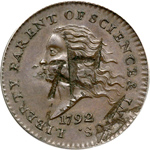 |
1792 Copper Disme. . Judd-11. Pollock-12 Rarity-8. PCGS graded "Genuine". Our Grade MS-64 Brown. Unique Discovery Specimen With Cancellation Marks. The present specimen is undoubtedly one of the most intriguing and stunning coins that this firm has had the opportunity to handle. We begin with a description of the surfaces, which we note as Mint State 64 Brown. Light chocolate coloration with only the slightest darker brown tone on the high points. There is no evidence of wear of any sort and the entire coin has the appearance of a presentation piece. Obviously, one immediately sees the two large "X's" on the obverse with a small area near 5:00 on the obverse that is either a small portion of a third "X" or a planchet defect. On the reverse, there are areas of flatness that correspond to the marks on the obverse. Currently, the exact nature of these markings can only be speculated over and while we will attempt to do just that, feel free to come to your own conclusions. We feel the current coin is a presentation piece of the Plain Edge 1792 disme and that the coin possesses cancellation marks. Generally, the cancellation occurs on the die itself and therefore, the corresponding cancelled coins have raised marks where the metal would flow into the depressed cancelling marks on the die. From the historical information that is mentioned below, we know that a single obverse die of this design can be accounted for. Since both Plain Edge (Judd-11) and Reeded Edge (Judd-10) examples are known for the 1792 copper disme, it seems entirely possible that Plain Edge examples were struck, then rejected in favor of the production of reeded edge examples. Obviously, with only one die in existence, the coin itself had to be cancelled rather than the die. Since the roster of known examples of the Judd-10, Reeded Edge copper disme contains 14 specimens (one with whereabouts unknown) and not a single specimen has been documented with cancellation marks, it is a possibility that the Plain Edge was quickly discontinued after its initial striking. Prior to the appearance of this discovery coin, only 2 specimens of the Judd-11, Plain Edge 1792 copper disme were known. The first being the specimen previously owned by Adam Eckfeldt/U.S. Mint Collection, later to Dr. Edward Marris and sold in the Garrett Collection in 1981. The second example was the specimen sold by Empire Coin Co. in 1961, current location unknown.
The method of delivery of both cancellation marks appears to have come from the same tool, most likely a chisel. When measuring the central, most pronounced "X", the distance from the intersection of the lines to the end of each leg of "X" is 4.6mm. The second mark, further to the left and incomplete still allows for a single measurement to be made from the intersection to the end of one leg, once again measuring 4.6mm. Both marks are of the same depth and same character, with one side of the recessed area being vertical and the other spreading out more shelf-like. The third mark, closer to 5:00 on the obverse is questionable. It appears to be the same nature of the cancellation marks, especially when considering depth and form, but it is too incomplete. Here it is seems possible that a planchet defect occurred closest to the border and a single chisel mark was punched over it. On the reverse, the areas of flatness correspond with the areas of cancellation on the obverse. It seems that the first central cancellation punch would have produced the flatness seen over the majority of the eagle. The second punch produced the flatness seen towards the left, also causing the scrape marks seen on the flattened eagle as the reverse coin shifted from the force of the blow.
The coinage produced during the period just prior to the opening of America's first national minting facility has become the most coveted and romantic of American numismatics. Not a single appearance of a 1792 half disme, disme, cent, silver center cent, birch cent or Wright quarter dollar occurs without reflection on the birth of our nation's first mint and furthermore, the evolution of our monetary system and new nation. The striking of these 1792 pattern issues represents a commitment to the national coinage system first proposed by Robert Morris in 1785, later refined by Thomas Jefferson and officially accepted by Congress on July 6, 1785, when the unit of the United States decimal monetary system officially became the dollar. The dollar, with its underlying decimal counterparts, has gone on from that beginning to be the foundation of the modern worlds' economic heartbeat and is a symbol of the "superpower" status fo the United States of America.
When Congress approved the establishment of the first United States Mint in April of 1792, they acted quickly to make sure this first Mint would come to fruition. Proposals for a national mint had been made earlier, in 1782 and 1790, with nothing ever materializing and it was time to act. President George Washington selected David Rittenhouse to be the first Director of the Mint. A lot on Seventh Street in Philadelphia was purchased and prepared for the construction of the first national minting facility. On July 31, 1792, the cornerstone of America's first mint was laid by David Rittenhouse
At George Washington's request, a portrait of himself was not to be placed on the coinage of our country. Instead, a portrait emblematic of Liberty was developed and placed on these 1792 patterns. When viewing the 1792 disme obverse design, one cannot help but notice striking similarities between the issue and the 1793 half cent. Don Taxay, in The U.S. Mint and Coinage, cited evidence of the creation of the 1792 Disme and mentioned a certain individual by the name of B.L.C. Wailes who visited the Mint in 1829. Mr Wailes, after returning from a Mint visit, was recorded as stating,
"Mr. Eckfeldt, one of the Superintendents (the second in grade) is an artist and has been in the Mint from its first establishment. [He] made the first dye used in it."
Taxay went on to comment that the die mentioned by Mr. Wailes is most certainly the 1792 disme and since only one die can be associated with Mr. Eckfeldt (based upon the comments of Mr. Wailes), then the reverse die should be associated with Robert Birch. Further speculation on the connection between the 1792 disme obverse design and Adam Eckfeldt comes from the presentation of a 1793 half cent by Adam Eckfeldt to another individual as an example of his work. This event was mentioned by Walter Breen, Andrew Pollock III and Don Taxay, based on W. Elliot Woodwards' 1863 auction of a 1793 half cent. The passage quoted in Taxay's U.S. Mint and Coinage is as follows: "A peculiar interest attaches to this coin. Nearly sixty years since it was presented to a gentleman, by Mr. Adam Eckfeldt, as a specimen of his work, and has remained in the possession of the person to within a few days."
Regardless of the exact nature of this piece, the curiosity that it spawns and its near-gem appearance (when not taking into consideration the cancellation marks) make this one of the most interesting coins to come to the numismatic community in years. The discovery of this piece does not diminish the Rarity-8 status of the Plain Edge 1792 Copper Disme and in fact, enhances the variety by adding mystery to its production. Whether a collector of the most prominent early type coins or a collector already possessing some example of the 1792 pattern coinage, you will respect that this specimen is unique and intensely desirable as such!
Estimated Value $30,000 - 50,000.
View details and enlarged photos
| Realized
$55,200 |
Lot 806 |
 |
1792 Pattern Cent. Copper, reeded edge. No Silver Center. . Judd-2. Pollock-2 Rarity-7. PCGS graded VF-30 PQ. A monumental offering of this fantastic discovery piece! This 1792 Copper Cent has just come out of the woodwork and its history and path to the present are enshrouded in mystery. The technical qualities of this specimen are outstanding and characterized in brief by smooth, clean surfaces, pleasing coloration and honest and even wear. We feel that this example should most likely be considered the 3rd or 4th finest known of the nine specimens accounted for. The opportunity to purchase a coin of this caliber comes around very seldom, often decades in between, if ever at all.
The year 1792 was very significant for the beginning of our monetary system and our first Mint: George Washington selected David Rittenhouse to be the first Director of the Mint; a lot was purchased in Philadelphia with the sole intention of building the minting facilities on it; copper was purchased for coining on presses newly arrived from England; and several denominations of coinage were struck in silver and copper. Newly elected and hired, Mint personnel and authorities immediately started experimenting with design and logistical considerations such as the 1792 Silver Center Cent and fusible alloy cent. This fusible alloy concept, supposedly proposed by Henry Voigt, sought to circumvent the production of pure copper cents due to the large size their planchets would be, such as the 1792 Birch Cent. Therefore, Voigt thought that by mixing copper and silver together, a combination called billon, a smaller planchet size cent could be produced, and, indeed, a single confirmed fusible alloy cent (the Harmer-Rooke specimen) proves that production of this concept occurred. One obvious problem comes to mind with this idea: how could the public know any given cent had the right amount of silver alloyed with the copper? Even today it takes very expensive X-ray fluorescence equipment to determine this. Addressing this potential problem at the time, officials decided that the last thing our new coinage needed was the potential for claims of fraud via planchets not having the correct balance of # of a cent's worth of silver with ¼ of a cent's worth of copper. The fusible alloy cent was "vetoed" with a unanimous "you're fired".
Keeping all this in mind, all 1792 Judd-2 examples should be considered struck in pure copper unless tested by current equipment to determine whether or not traces of silver are present. Adding to the mystery and desirability of the present offering is the fact that until tested, it is possible that this specimen could be a fusible alloy example. The cataloguer of the Norweb Sale pointed out that of the 8 specimens traced at that time, only one, the Harmer-Rooke specimen, had been tested and confirmed to be a fusible alloy example.
The quality of this groundbreaking discovery is fantastic. Surfaces display a very light degree of porosity which is easy to come to terms with when weighed against the qualities of the rest of the coin. Device and legend detail is even and appears to be sharper than the designated grade of VF30. The delineation between the top of the forehead and beginning of the flowing hair is sharply defined. Planchet quality is very pleasing and above average. There is some dark verdigris that has settled into the letters and around the devices, frequently seen on these early copper patterns. No rim bruises are seen and the fields are remarkably free from scratches, ticks or hits. With regard to the dies, the N's in SCIENCE and INDUSTRY are missing feet on the lower right serif. The letters in the legend display bifurcation on their feet. The R in AMERICA has a long stem and the top of R is open, giving a "LIBKERY" appearance. On the reverse, the C in CENT is low and the second 0 of 100 touches the fraction bar.
In our Benson Sale Part I, February 2001, we were fortunate enough to have the opportunity to sell Condition Census example #4, the Lauder Specimen (PCGS VG-10). The cataloguer of the Norweb Sale, 11/88:3393, created a list of known specimens for the 1792 Copper Cent. We present that same list here in an attempt to illustrate how high up on the Condition Census this discovery piece is:
1) National Collection
2) Norweb, second finest
3) Garrett: 2348, ex-Maris, Seavey
4) Lauder: 234, Bowers and Ruddy's Rare Coin Review, #53
5) ANA Museum, ex Paramount's Century Sale, 1965:50; Pine Tree 2-21-1975:69
6) Harmer-Rooke 11-69; to a private collection, Good to Very Good, porous
7) Lohr (1961); River Oaks, Bower and Ruddy, 1976:909; Stack's 1-14-78:476, Good, porous
8) Crosby, Plate X, 12, the Appleton-MHS coin, now untraced
It is with great excitement that we offer this previously unknown example and one ranking near the quality of the Norweb and Garrett specimens. The early American copper patterns are not just rare coins; they are artifacts of our nation's birth and representatives of freedom and liberty and the American dream to succeed. To further illustrate the unquestionable connection between this coin and the founders of our great nation, we delve into the fantastic pedigree accompanying this specimen (PCGS # 11004) .
Estimated Value $250,000 - 350,000.
The present specimen comes from a family with direct ties to the Colonial and early national periods of our nation. The Wolcott family first arrived in America in 1636 when Henry Wolcott settled in Windsor, Connecticut. Mr. Henry Wolcott is known to have been an English gentleman of considerable fortune and his arrival to Connecticut marked the beginning of many generations of direct involvement and leadership in Connecticut public and financial affairs, as well as direct involvement in the creation of our nation's unity. While we could write an entire story about the influence that Henry Wolcott had on our early nation our focus is on Oliver Wolcott and Oliver Wolcott, Jr., for this is where the plot really thickens!
Oliver Wolcott was a 4th generation direct descendent of Henry Wolcott. Like his predecessors, he was involved in forming and forging the new identity of America. Born in 1726, Oliver Wolcott later graduated from Yale, was appointed to the position of Captain in the army in the French War, received service decoration for his duty at our northern frontiers, had a seat in the Second Congress in 1776, signed the Declaration of Independence and, lastly, served as the Lt. Governor of Connecticut. Throughout all of these achievements, he also managed to establish a family, and it is his son, Oliver Wolcott, Jr., that is perhaps the direct link to the beginning of this 1792 Copper cent's journey to its present offering in the year 2004. Oliver Wolcott, Jr. was born in Litchfield, Connecticut in 1760 and died in New York City in 1833. Throughout that time period, he amassed a resume just as impressive in its own right as his father's and continued the generational trend of direct involvement in the creation of our new nation. Yet it is his direct involvement with our newly created Treasury that is of vital importance to the journey of this coin. Oliver Wolcott, Jr. served as Comptroller of the U.S. Treasury from 1791-1795, and at the young age of 35, succeeded Alexander Hamilton as the 2nd Secretary of the Treasury by direct appointment by President George Washington! He held this position from February 3rd, 1795 through March 3rd, 1797 under President Washington then President John Adams continued his post until December 31, 1800. It is during this time period, 1791-1800, that one can speculate on all sorts of scenarios that led to the Wolcott family's coming into possession of this fabulous 1792 copper cent. Anyone who has studied early American numismatics can recite the facts about the establishment of our First Mint in the 1792-1793 time frame. Perhaps it is during this period that George Washington himself gave Oliver this cent. No one will ever know for sure, but the historical and genealogical facts surrounding this family and the subsequent surfacing of this Condition Census 1792 Copper issue will allow an endless speculation to occur over the journey this specimen has taken. We are thrilled to offer this groundbreaking specimen to our bidders and the numismatic community!
View details and enlarged photos
Check results on similar lots
| Realized
$437,000 |
Lot 807 |
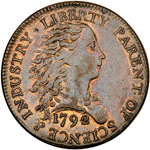 |
1792 Birch Cent. Electrotype Copy. A copper electrotype representation of one of America's most desirable coins, probably for a museum display. The 1792 Birch Cent is a "dream coin" for about 99.999999% of all collectors, regardless of financial status. Just viewing the original Judd-2 and Judd-11 examples of the present sale, one can easily understand how a serious love affair can develop with any copper pattern of 1792. Unfortunately, obtaining any 1792 pattern is going to require some serious bucks and a nice amount of luck! For all of our bidders who would like a representation of this famous issue, here is your chance. Electrotyping is a process, commonly utilized by museums, by which an impression of the original coin is produced in wax, or something similar, and coated in an electrical conductor. The present copy used copper as the conduit and resulted in a single shell. It appears that only an obverse copy was made for the inside of the shell appears that it was not filled. The surfaces have light brown color and a glossy luster. All detail is sharp, a perfect model of the Birch Cent, very choice About Uncirculated.
Estimated Value $500 - 1,000.
View details and enlarged photos
| Realized
$978 |
Lot 808 |
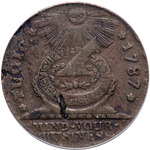 |
1787 Fugio Cent. PCGS graded VF-30. Light brown coloration. Struck on planchet that has a host of flaws, most noticeably above the ND of MIND. Well centered and the lettering is strong. "MIND YOUR BUSINESS" is clear.
Estimated Value $550 - 650.
View details and enlarged photos
| Realized
$661 |
|
|